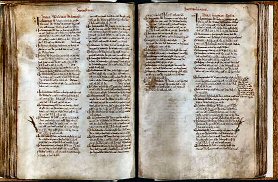

|
The Domesday Book has probably had more written about it than any other book apart from the Bible, but still a lot of the detail is not understood. The entries give the name of a manor, its owner in 1086 and in the year of the Conquest, how much land there was for a certain number of ploughs, the amount of meadow, pasture, and woodland in acres, stock numbers, and the value of the land at both dates. "At Midwinter, 1085, was the king in Gloucester with his Council, and held there his court five days. After this the king had a large meeting, and consulted deeply with his council about this land; how it was occupied, and by what sort of men. Then he sent his men over all England into each shire; commissioning them to find out "How many hundreds of hides were in the shire, what land the king himself had, and what stock upon the land; or, what dues he ought to have by the year from the shire." Also he commissioned them to record in writing, "How much land his archbishops had, and his diocesan bishops, and his abbots, and his earls;" and though I may be prolix and tedious, "What, or how much, each man had, who was an occupier of land in England, either in land or in stock, and how much money it were worth." So very narrowly, indeed, did he commission them to trace it out, that there was not one single hide, nor a yard of land, nay, moreover (it is shameful to tell, though he thought it no shame to do it), not even an ox, nor a cow, nor a swine was there left, that was not set down in his writ. And all the recorded particulars were afterwards brought to him." The basic unit of land in the Domesday Book is the Manor; Manors could be larger or smaller than just one village, but all consisted of land and had jurisdiction over the tenants. These were part of larger administrative subdivisions of land called Hundreds, which contained several manors and had their own assembly of notables and representatives from local villages. The manors were very diverse in size and although they appear from Domesday to be very typical; compact, centred on a church and separated by open land, they were not. Instead, habitations in most areas of late 11th century England followed a very ancient pattern of isolated farms, hamlets and tiny villages interspersed with fields and scattered over most of the cultivable land. As in the Iron Age, over time the settlements gradually shifted or were abandoned or reclaimed.In Saxon times, Witheridge came in the category of committal lands, lands that were set apart for the maintenance of the Earl and his family. At the death of King Edward, the Manor was held by Countess Githa, widow of the Earl Godwin and mother of King Harold. After her defeat at Exeter, William took it into his own hands and so it remained at Domesday in 1086. The King has a Manor called Wiriga, which Githa held in the time of Edward the Confessor. Within a few years of the Norman invasion, William had dispossessed nearly all of the Saxon landowners, and proceeded to share out the lands in England amongst his Norman supporters. As in the case of the manor of Witheridge, he kept most of the royal lands for himself. Of the other local manor's, the Kings Shire-Reeve, or Sheriff of Devon, Baldwin, held a small manor of Wilson. Sometimes lands were handed out to members of the same family. This was the case with Queen Dart and Essebeare, both of which were given to Odo FitzGamelin, while the Theobald who owned the "Washford" Dart was Odo's father in law. It is worth noting that Theobalds tenant at the latter was Alwold, the Saxon who held the manor before the Norman Conquest. He must have been considered no threat to the new regime. Dart Raffe was owned by William de Poilli, whose tenant was Ralph, after whom the farm was named. At the time of Domesday in 1086, there were only 18 towns with a population of over 2000 inhabitants in England. Of these, one was Exeter, and the two largest, London and Winchester, were left out of the Domesday Book entirely. The population of the entire country was probably between 1.2 and 1.5 million, most of them in the south and east. Previous Last Edited 03/07/2006 Copyright © 2000-2006 Witheridge Unless otherwise indicated on the page in question, the photographic images reproduced on this site belong to the Witheridge Archives, and, as such may not be reproduced for commercial purposes without written permission. However, you are welcome to use any of the photographs belonging to the archive for personal and/or non-commercial use. Any material shown as not being owned by the archive may not be reproduced in any form without first receiving written permission from the owner of the material in question. The picture of the Domesday Book is reproduced with thanks to the National Records Office at Malden in Surrey. |


